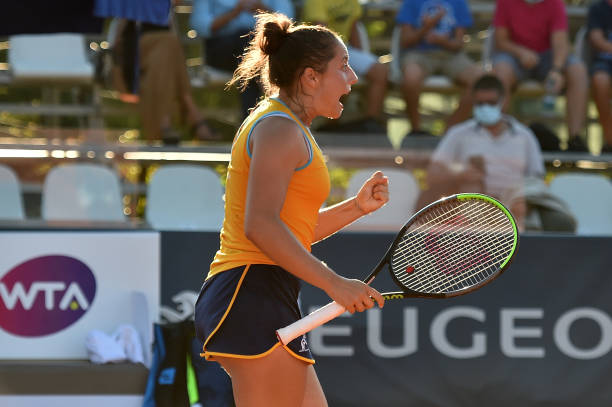10 Tips On Surface And Conditions While Making Tennis Predictions
It is essential to analyze the surface and conditions of play when making predictions for tennis. Here are ten methods to analyze these variables effectively: Surface Preferences Different players excel on various surfaces. Clay specialists may struggle with grass. Hardcourt players may feel that clay courts are too slow. Think about a player’s past performance on the surface that you’ll be playing on.
The speed of courts can be different even when the surface is similar. Courts that are faster, such as grass and some surfaces that are hard favour aggressive players and big servers. The slower courts (like clay), in contrast, benefit those with a lot of stamina and are a baseline grinder.
The surfaces have different effects on the bounce of a ball. Clay courts have a high bounce that is beneficial to players with heavy topspin. However grass courts bounce lower, and this is ideal for players who are flat or serve-and-volley players, as well as those who have less topspin.
Weather Conditions: Weather can alter the playing conditions dramatically manner. High temperatures may cause the ball to move faster, but humidity may hinder it. Wind can disrupt timing and favour players who are more adaptable.
Indoor vs. Outdoor: Indoor conditions are free of factors like sun or wind. This makes the game more predictable, and it favors players who are able to make precise powerful shots. Outdoor matches require greater adaptability because of changing conditions of the weather.
The ball can be more powerful and bounce better in high-altitude regions (like the ones in South American tournaments). This is because of the less dense air. This usually favors the most aggressive players as well as strong servers.
Recent Surface Change: Participants often struggle with transitioning between surfaces. This is especially the case in the first rounds of a tournament. You can make predictions based on the amount of time since a player’s shift from one surface to the next was.
Some tournaments are unique with distinct characteristics, such as the type of ball or adjustments to altitude. Understanding these specifics can give you a competitive edge in predicting results.
Time of the match When playing on slower surfaces such as clay matches can be longer in duration, favoring those with superior stamina and consistency. Conversely, surfaces with faster speeds result in shorter rallies and more points.
Preparation & Adaptability Some players are able to adapt to different surfaces quickly but others need longer. Analyze how a player has adapted to different surfaces, particularly when a new tournament starts.
When you consider these elements of surface and conditions in your tennis prediction, you’ll be able to have an accurate understanding of tennis matches. Follow the best Tennis Prediction News Of The Day for more info including us open tennis betting, betting sites for tennis, betting odds for tennis, match tips, to day prediction, tennis betting, atp tennis predictions today, us open odds womens, tennis betting sites, best sports prediction site and more.

10 Tips For Tournament Context When Making Tennis Predictions
In making predictions for tennis knowing the context of the tournament is vital. Here are 10 things to think about: Tournament Tier and Prestige A lot of players will choose certain tournaments over other. Grand Slams and Masters 1000 events typically see top players giving their best and most lower-level tournaments may not see the same level of effort from top-ranked players.
Defender Points: Players who performed excellently in the previous tournament are able to defend their ranking points. defend, which may provide extra motivation. For players with fewer points on the line might not feel the same stress.
Player Motivation: Take into account the motivation of the player. If a player’s motivation is driven by a ranking goal the last-minute bid for the title, or a remarkable turnaround, they could show up in certain tournaments.
Surface Suitability – Certain tournaments are known to have specific conditions for the surface (e.g. the fast grass in Wimbledon, or slow clay in Monte Carlo). These types of conditions are usually an ideal match for players.
Home Advantage – Sportsmen tend to perform better when playing in the country or the area where they reside. The support of the local community can improve confidence in players and performance.
Analyze draw strength: Evaluate the strength of the tournament’s draw. A draw that is top heavy with many elite players in one section could lead to early upsets, while a weaker section might let lower-ranked players move further than normal.
Player Form Leading Into the Tournament: Determine the level to which a player has performed leading up to the event. Players with good form are more likely than others to keep their current pattern.
Fatigue and Match Load Think about a player’s most recent match schedule. A lengthy schedule of matches leading up to a tournament can cause fatigue. But, too little game time may be a sign that the player is not in a good state for playing.
Tournament The history of the tournament. Certain players are able to win certain tournaments due to favorable conditions, their comfort with the area or personal preferences. Review the previous performance of every player who has participated in this event.
Round-by-round performance: Some athletes may begin slow in tournaments, but gain confidence as they advance, whereas others may perform well in the early rounds but struggle in later rounds. Understanding these tendencies can help you determine the outcomes at various stages of the tournament.
You can improve your tennis predictions by taking into account these aspects. View the top Tennis Predictions & Picks for blog info including sure win prediction today, betting predictions today, atp tennis picks, best picks today, betting set, tennis betting tips, best picks, best tennis bets today, good betting prediction sites, wta tennis odds and more.

10 Tips About Betting Odds When Making Tennis Predictions
To make accurate tennis predictions, it is essential to understand betting odds. Here are ten tips on how to use betting odds effectively:Understand the Odds Formats: Familiarize yourself with different odds formats–decimal, fractional, and moneyline. Understanding these formats will assist you calculate the returns and interpret odds more accurately.
Comparing Odds Across Bookmakers: Different bookmakers may provide slightly different odds for the same game. Comparing odds between multiple platforms can help you gain the best value for your bet.
Monitor Odds shifts: Be aware of how odds fluctuate in the weeks leading up to games. Changes that are significant could be a result of public perception, injury or other factors that impact the performance of a player.
Calculate Implied Probability – Convert odds to implied probability to determine the bookmaker’s view of the gambler’s odds. You can then compare your predictions to the market’s expectations.
Check for Value Bets: Make note of any discrepancies that you observe between your estimation of the odds a gambler has and those provided by the bookmaker. There could be the option of a value bet when you feel a player has a higher chance of winning than odds indicate.
Consider Recent Form Odds often reflect current injuries and player performance. Be sure to keep up-to date with information about players, since sudden changes in player news can impact the odds and bets.
The market is where you bet on the number of sets and games that are played during a match. Analyzing the players’ performance in the previous games will help you predict the length of matches and total games.
Check odds against previous head-to-head performances. It can provide insight on how odds could change based on historical performance.
Be aware of Tournament Context. Betting odds can be affected by tournament importance. Players may perform differently when playing high stakes games when compared to lesser-important ones. The context of the tournament can impact the probabilities.
Avoid Overreaction. Bookmakers often overreact when they are confronted with recent events. If the odds of a specific player have changed dramatically in recent games, consider if this changes accurately reflect their overall performance and future potential.
These tips will help you make better betting decisions. They will ensure that your predictions have an established foundation in the market and odds.






Recent Comments